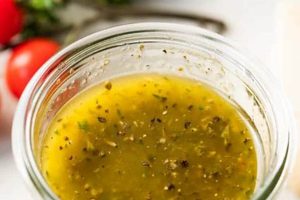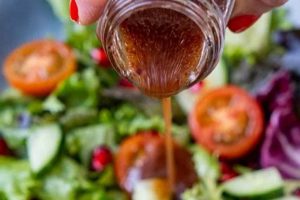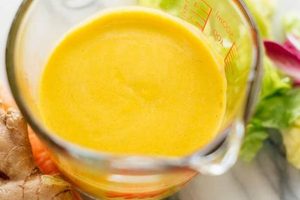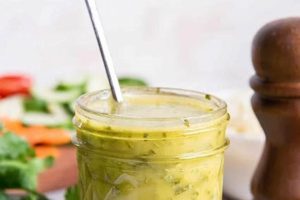A creamy, tangy, and nutty emulsion typically combines tahini, lemon juice, water, and seasonings. Optional additions include garlic, minced herbs, spices like cumin or paprika, and sweeteners like maple syrup or honey. This versatile dressing can be adjusted in flavor profile and consistency to complement various salads and dishes.
This dressing offers a healthy and flavorful alternative to traditional creamy dressings, often high in saturated fat. Tahini, a sesame seed paste, provides healthy fats, protein, and minerals. The addition of lemon juice contributes Vitamin C and antioxidants. The blends adaptability makes it suitable for everything from robust kale salads to delicate spring mixes, grain bowls, roasted vegetables, and even as a dipping sauce. Its increasing popularity reflects a growing interest in plant-based cuisine and globally inspired flavors.
Further exploration will cover variations in ingredients, techniques for achieving optimal emulsification, recommended pairings with different types of produce, and nutritional information.
Tips for Crafting the Perfect Tahini-Lemon Dressing
Achieving a balanced and flavorful dressing requires attention to ingredient quality and technique. The following tips provide guidance for optimal results.
Tip 1: Start with High-Quality Tahini: The flavor of the tahini significantly impacts the final result. Opt for a fresh, smooth tahini made from hulled sesame seeds for the best flavor and texture.
Tip 2: Balance Tanginess and Richness: Adjust the lemon juice quantity according to personal preference and the tahini’s natural bitterness. Start with a smaller amount and add more gradually until the desired balance is achieved.
Tip 3: Achieve the Perfect Consistency: The dressing should be smooth and pourable. Whisk in water, a tablespoon at a time, until the desired consistency is reached. Over-thinning can be remedied by adding more tahini.
Tip 4: Enhance with Garlic and Herbs: Minced garlic, fresh parsley, dill, or mint can elevate the flavor profile. Start with small amounts and adjust to taste.
Tip 5: Consider Sweetness and Spice: A touch of sweetness, such as maple syrup or honey, can balance the acidity. A pinch of cumin, paprika, or cayenne pepper adds warmth and complexity.
Tip 6: Proper Storage for Longevity: Store leftover dressing in an airtight container in the refrigerator for up to a week. The dressing may thicken upon refrigeration; whisk in a small amount of water to restore the desired consistency before serving.
Tip 7: Versatile Applications: While excellent for salads, consider using the dressing as a marinade for vegetables or proteins, a sauce for grain bowls, or a dip for pita bread and crudits.
By following these guidelines, one can consistently create a delicious and versatile tahini-lemon dressing.
These techniques offer a foundation for culinary exploration and personalization.
1. Tahini Quality
Tahini quality significantly impacts the final flavor and texture of a lemon tahini salad dressing. The choice of tahini influences not only the dressing’s overall taste but also its smoothness and emulsification stability. Lower-quality tahini, often made from roasted or lower-grade sesame seeds, can exhibit a bitter or burnt flavor, detracting from the desired balance of nutty, tangy, and savory notes. Such tahini may also contain stabilizers or additives that interfere with proper emulsification, leading to a separated or grainy dressing. For instance, a tahini with a strong bitter taste can overpower the brightness of the lemon, while a rancid tahini will ruin the entire dressing.
Conversely, high-quality tahini, typically made from raw or lightly roasted high-grade sesame seeds, delivers a smooth, creamy texture and a delicate, nutty flavor that enhances the lemon and other seasonings. This type of tahini emulsifies readily with liquids, resulting in a stable and visually appealing dressing. A premium tahini often contributes a subtle sweetness, balancing the tartness of the lemon juice. Practical applications of this understanding include selecting tahini specifically labeled “raw” or “hulled” for optimal results. Comparing different brands through taste tests can also help discern subtle flavor variations and identify preferred options. Investing in quality tahini ensures a superior foundation for the dressing and contributes significantly to the overall culinary experience. Consider a side-by-side comparison: a dressing made with high-quality tahini will be smooth, creamy, and flavorful, while one made with low-quality tahini may be gritty, bitter, and separate easily.
Ultimately, prioritizing tahini quality represents a crucial step in crafting a successful lemon tahini salad dressing. The difference between a subpar and exceptional dressing often hinges on the foundational ingredient. Awareness of these nuances allows for informed decisions when selecting ingredients, contributing to a more satisfying culinary outcome. Challenges in sourcing high-quality tahini may exist depending on location and access to specialty stores. However, the increasing demand for natural and wholesome foods has broadened availability, making it easier to locate superior products. This emphasis on quality aligns with a broader trend towards appreciating the impact of ingredient selection on overall flavor and culinary satisfaction.
2. Fresh Lemon Juice
Fresh lemon juice provides the essential acidic component in a lemon tahini salad dressing recipe. Its role extends beyond mere tartness; it balances the richness of the tahini, brightens the overall flavor profile, and contributes to the emulsion’s stability. Understanding the nuances of using fresh lemon juice is crucial for achieving a well-balanced and flavorful dressing.
- Acidity and Balance
The acidity of fresh lemon juice counteracts the inherent richness of tahini, preventing the dressing from becoming overly heavy or cloying. This balance is essential for a palatable and refreshing final product. The right amount of lemon juice creates a harmonious interplay between the nutty, earthy flavors of the tahini and the bright, citrusy notes of the lemon. Too little lemon juice results in a bland dressing, while too much can make it unpleasantly tart. For example, a salad with delicate greens may require less lemon juice than a heartier salad with roasted vegetables.
- Emulsification and Texture
Lemon juice plays a crucial role in the emulsification process, helping to bind the tahini and other ingredients together into a stable and creamy dressing. The citric acid in the juice interacts with the tahini’s oils, creating a smooth and homogenous mixture that resists separation. This emulsification contributes to both the texture and visual appeal of the dressing. Without sufficient lemon juice, the dressing may become grainy or separate into layers of oil and water. Adding the lemon juice gradually while whisking vigorously promotes a stable emulsion. For instance, a properly emulsified dressing will coat salad greens evenly, while a separated dressing will result in uneven flavor distribution.
- Flavor Enhancement
Beyond its acidic contribution, fresh lemon juice enhances the other flavors in the dressing. It brightens the taste of the tahini, allowing its nutty notes to shine through. It also complements other seasonings, such as garlic, herbs, and spices, creating a more complex and nuanced flavor profile. The aromatic compounds in lemon juice contribute to the overall sensory experience. Using bottled lemon juice can result in a flat or artificial taste, lacking the vibrancy of fresh juice. A taste test comparing dressings made with fresh versus bottled lemon juice will readily demonstrate this difference.
- Preservation and Storage
The acidic nature of lemon juice also acts as a natural preservative, extending the shelf life of the dressing. While refrigeration is still necessary, the lemon juice helps to inhibit bacterial growth and maintain the dressing’s quality for a longer period. This preservative quality is particularly important for dressings containing fresh herbs or other perishable ingredients. However, even with lemon juice, the dressing should be consumed within a reasonable timeframe for optimal flavor and freshness. Proper storage in an airtight container is essential to prevent oxidation and maintain quality. For example, a dressing stored correctly might last for up to a week, whereas improper storage could lead to spoilage within a few days.
The interplay of these facets demonstrates the significant impact of fresh lemon juice on a lemon tahini salad dressing recipe. From balancing richness and promoting emulsification to enhancing flavors and extending shelf life, fresh lemon juice contributes significantly to the overall quality and enjoyment of the dressing. Understanding its multifaceted role allows for greater control over the final product, enabling culinary creativity and consistent results.
3. Balanced Seasonings
Balanced seasonings are essential for a nuanced and flavorful lemon tahini salad dressing. The inherent flavors of tahini and lemon juice provide a foundation, but strategic seasoning elevates the dressing beyond basic. The interplay of salt, garlic, herbs, spices, and optional sweeteners creates complexity and depth, transforming the dressing from simple to sophisticated. Consider the effect of garlic: a small amount adds a pungent savory note, while too much can overpower the other flavors. Similarly, the right balance of herbs, such as parsley or dill, can complement the nutty tahini and bright lemon, while excessive amounts can create an undesirable “green” taste. The judicious use of spices, like cumin or paprika, adds warmth and complexity, but an overabundance can create an overly assertive flavor profile. Even a touch of sweetness, from maple syrup or honey, can play a crucial balancing role, mitigating excessive acidity and enhancing the overall flavor harmony. Achieving this balance requires careful consideration of individual ingredients and their synergistic effects.
A practical example illustrates this principle. A lemon tahini dressing intended for a Mediterranean-style salad might benefit from the addition of dried oregano, mint, and a pinch of sumac, complementing the flavors of olives, feta cheese, and cucumbers. Conversely, a dressing designed for an Asian-inspired salad might incorporate ginger, soy sauce, and sesame oil, harmonizing with ingredients like shredded carrots, edamame, and toasted sesame seeds. Understanding these flavor affinities allows for tailored seasoning choices, enhancing the overall culinary experience. The balance also considers the inherent saltiness of the tahini. Adding too much salt can easily overpower the other flavors, while too little can result in a bland dressing. The goal is to enhance, not mask, the core flavors of tahini and lemon.
Mastering balanced seasoning in a lemon tahini dressing empowers culinary creativity and customization. It allows for adaptation to specific dietary needs and preferences, such as reducing sodium or using alternative sweeteners. Successfully navigating these nuances elevates the dressing from a functional component to a flavorful centerpiece, enhancing the overall dining experience. The challenge lies in finding the optimal balance for each ingredient, requiring experimentation and taste adjustments. However, the rewards of a well-seasoned lemon tahini dressing, offering a complex and satisfying flavor profile, outweigh the effort. This principle of balanced seasoning extends beyond this specific recipe, applying to a broad range of culinary endeavors, highlighting the importance of thoughtful ingredient combination and flavor development.
4. Proper Emulsification
Proper emulsification is crucial for the texture, stability, and overall quality of a lemon tahini salad dressing. It transforms individual ingredientstahini, lemon juice, water, and seasoningsinto a cohesive, creamy, and visually appealing sauce. Without proper emulsification, the dressing separates, resulting in an oily layer on top and a watery layer below, compromising both flavor and mouthfeel.
- The Science of Emulsification
Emulsification involves combining two immiscible liquids, typically oil and water, into a stable mixture. In a lemon tahini dressing, the tahini (containing sesame oil) and the lemon juice (primarily water) are the two immiscible components. An emulsifier, in this case, the tahini itself, acts as a bridge between these liquids, allowing them to disperse evenly and remain suspended. The tahini’s inherent emulsifying properties are enhanced by the lecithin present in sesame seeds. This process creates a homogenous mixture that prevents separation and delivers a consistent flavor experience in each bite. For instance, without emulsification, the oil and water would separate, with the oil rising to the top, resulting in an unbalanced and unappetizing dressing.
- Techniques for Achieving Emulsification
Several techniques facilitate proper emulsification in a lemon tahini dressing. Whisking vigorously while slowly drizzling in the lemon juice and water encourages the tahini to break down and evenly disperse within the aqueous phase. A blender or food processor can also achieve emulsification, but requires careful monitoring to avoid over-processing, which can lead to a gritty texture. Starting with a smooth, high-quality tahini, free from graininess or separation, significantly aids the process. For example, slowly incorporating the lemon juice while continuously whisking creates a stable emulsion compared to dumping all the liquid at once.
- Factors Affecting Emulsification
Several factors can influence the stability of the emulsion. Temperature plays a role; extreme heat or cold can destabilize the mixture. The ratio of ingredients is also critical; too much oil or water relative to the tahini can overwhelm the emulsifier and cause separation. The addition of other ingredients, such as garlic or spices, generally does not interfere with emulsification but can affect the dressing’s overall consistency. For instance, a dressing left in a hot car may separate due to temperature fluctuations, while using too much water can result in a thin, unstable emulsion.
- Indicators of Successful Emulsification
A properly emulsified lemon tahini dressing exhibits several key characteristics. The mixture appears smooth, creamy, and opaque, without visible separation of oil and water. It coats the back of a spoon evenly, indicating a stable emulsion. The texture is consistent throughout, without any grittiness or oiliness. The flavor is balanced and well-distributed, with no pockets of excessive oil or acidity. For example, a dressing that separates upon standing or reveals oil slicks on the surface indicates improper emulsification.
Achieving proper emulsification is paramount to a successful lemon tahini salad dressing. It ensures a desirable texture, prevents separation, and contributes to a balanced and harmonious flavor experience. Understanding the scientific principles, employing effective techniques, and recognizing factors that influence emulsion stability allows for consistent results and a superior culinary outcome. The ability to create and maintain a stable emulsion extends beyond this specific dressing, applying broadly to sauces, dips, and other culinary preparations, highlighting the fundamental importance of this skill in achieving desired textures and flavors.
5. Versatile Applications
The versatility of lemon tahini dressing extends beyond its traditional role as a salad accompaniment. This adaptability stems from its balanced flavor profilenutty, tangy, savoryand its adaptable consistency. Its potential uses span a wide range of culinary applications, transforming it from a simple dressing into a multifaceted ingredient. This versatility contributes significantly to its appeal, offering cooks a convenient and flavorful tool for enhancing various dishes. For example, the dressing functions effectively as a marinade for grilled chicken or fish, imparting a rich, nutty flavor and promoting tenderization. It also serves as a flavorful sauce for roasted vegetables, adding depth and complexity. As a dip, it pairs well with pita bread, crudits, or falafel, offering a healthier alternative to traditional dips. Furthermore, it can be thinned with water or broth to create a flavorful sauce for grain bowls or noodles.
This adaptability derives from the inherent properties of its core ingredients. The tahini provides a creamy texture and nutty base, while the lemon juice adds brightness and acidity. These foundational elements allow for seamless integration into a variety of culinary contexts. The dressing’s versatility also simplifies meal preparation, allowing for a single sauce to serve multiple purposes. This efficiency appeals to busy cooks seeking streamlined meal solutions. Consider its application as a sandwich spread: it adds flavor and moisture while replacing less healthful options like mayonnaise. Or, imagine using it as a base for a vegetable stir-fry sauce, eliminating the need for multiple ingredients and complex flavor balancing. This adaptability encourages culinary exploration and experimentation, empowering cooks to incorporate the dressing into new and innovative ways.
Understanding the versatile applications of lemon tahini dressing expands its culinary potential significantly. It transitions from a singular use condiment to a versatile ingredient capable of elevating a wide array of dishes. This adaptability not only simplifies cooking but also promotes creative flavor combinations, enriching the overall culinary experience. One potential challenge lies in adapting the dressing’s consistency for different applications. For marinades, a thicker consistency is desirable, while sauces and dips may benefit from thinning with water or broth. Mastering these adjustments allows for optimal results in various culinary contexts. This versatility reflects a broader culinary trend toward multi-purpose ingredients and simplified cooking techniques, highlighting the dressing’s relevance in contemporary kitchens.
Frequently Asked Questions
This section addresses common inquiries regarding lemon tahini salad dressing preparation and utilization.
Question 1: How can separation in the dressing be prevented?
Proper emulsification is key. Whisking constantly while slowly adding the lemon juice and water helps create a stable emulsion. Using a high-quality, smooth tahini also contributes to stability.
Question 2: What can be substituted for lemon juice?
Other citrus juices, like lime or orange, can be substituted, but will alter the flavor profile. Apple cider vinegar offers a non-citrus alternative, contributing a slightly different tang.
Question 3: How long can the dressing be stored?
Refrigerated in an airtight container, the dressing typically lasts up to one week. Signs of spoilage include discoloration, off-odors, or mold growth.
Question 4: Can the dressing be used on warm dishes?
While primarily used cold, the dressing can be drizzled over warm dishes just before serving. Avoid prolonged heating, which can cause the emulsion to break.
Question 5: What are common flavor pairings for this dressing?
The dressing complements Mediterranean flavors, pairing well with cucumbers, tomatoes, olives, feta cheese, and herbs like parsley and mint. It also enhances roasted vegetables and grilled meats.
Question 6: How can the dressing’s consistency be adjusted?
For a thinner dressing, add more water, a tablespoon at a time. For a thicker dressing, incorporate additional tahini until the desired consistency is achieved.
Understanding these aspects contributes to optimal results and culinary satisfaction.
The following section offers variations on this classic recipe, expanding culinary possibilities.
Lemon Tahini Salad Dressing Recipe
Exploration of this recipe reveals a versatile culinary asset. From ingredient selection and emulsification techniques to flavor balancing and diverse applications, the preparation and utilization of this dressing offer significant culinary potential. Emphasis on high-quality tahini, fresh lemon juice, and balanced seasonings contributes to a superior final product. Understanding the principles of emulsification ensures a desirable texture and stability. Recognizing the dressing’s adaptability, from salads to marinades and beyond, unlocks its full culinary range.
This exploration encourages informed culinary practice and ingredient appreciation. The seemingly simple combination of tahini and lemon juice, when approached with intention and understanding, yields a remarkably versatile and flavorful result. Further experimentation and adaptation promise continued culinary discovery.






